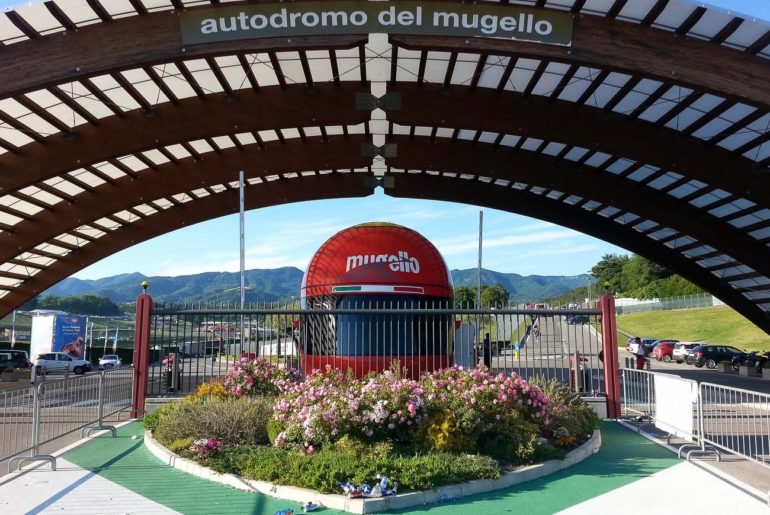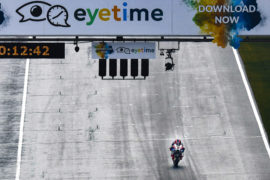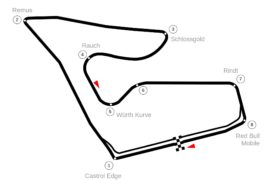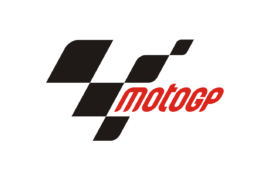There is no such thing as an ideal race track. Circuits are bound by the iron laws of reality: Grand Prix level tracks have to fit a given distance (between 3.5km and 10km) of track into the available space, in a layout which will allow powerful vehicles to stretch their legs.
They have to be somewhere where noise is not an issue, either as a result of being isolated from the general population, next to another source of noise such as an airport, or situated near a willing and enthusiastic town or city.
They need to have space for the fleet of trucks which transport the paddock from circuit to circuit, and they have to be accessible to those trucks via roads wide enough to let them pass.
Last but not least, they have to provide an attractive setting which fans want to visit, and good viewing over as much of the track as possible.
All these things militate against the existence of the ideal circuit. Find a space which is away from hostile neighbors, and it may be too small to create anything other than a tight, contorted track layout unsuitable for MotoGP bikes.
Or it may be on a hilltop, with few natural viewing opportunities. Or it may be too far from large population centers to make it easily accessible for fans, or lack the space for a usable paddock layout.
Yet something approaching the ideal circuit truly exists. A track where the bikes can use all of the 270+hp at their disposal.
A track which challenges every aspect of the rider, from managing their reactions at 360 km/h, to braking late and entering corners hard, to sweeping through fast combinations of turns carrying as much speed as you dare without washing out the front or having the rear come round and bite you.
A track with a roomy paddock, near a major highway, and several large population centers. In a country full of bike-mad fans. Set in a valley among some of the most enchanting scenery on the planet.
Oh yes, and the food in the paddock restaurant is some of the best you will eat all season.
A Bit of Everything, And More
Mugello. Of course I am talking about Mugello. You can argue whether some tracks are better in some aspects. Whether Phillip Island is a greater challenge in terms of speed. Whether the scenery at the Australian track matches the backdrop of Mugello.
Whether the flowing section from Mandeveen to the GT Chicane at Assen is more challenging than Casanova/Savelli and the Arrabbiatas. Whether the left-right combinations at Brno are better for overtaking than the ones at Mugello.
Whether staying in a villa in the Tuscan hills beats staying in a village up a mountain road in Aragon, or in the heart of historic Barcelona. But only at Mugello does it all come together to approach perfection. A great track in a great place offering a great challenge to both rider and machine.
That’s not to say that Mugello is perfect, however. The very speed of the circuit creates danger – the official top speed record at the track is 354.9 km/h, but that’s because speeds are so high at the circuit that the speed trap is already in the braking zone, meaning the bikes regularly hit over 365 km/h, and will soon be nudging 370 km/h.
But the track itself is hemmed in by the walls of the valley it sits in, so adding runoff is no longer an option. The wall at the end of the main straight is too close on the left hand side.
The runoff at Poggio Secco and Borgo San Lorenzo is minuscule. And only some smart combining of hard standing and gravel saved riders from reaching the wall at Materassi.
The magic of Mugello comes from its sheer outright velocity, but if the bikes get any faster, the track will simply no longer be safe enough to race on.
The physical geography of the circuit, its topology, the shape of the valley it sits in, the slopes of the hillsides the track snakes across, all these are the limiting factors of the track.
It is pretty much impossible to create any more runoff to make the track safer, without excavating large chunks of the countryside.
It’s almost as if Neptunus Equester came from the Mediterranean and swam up the river Sieve to merge at Luco di Mugello and trace the lines of the perfect track for modern chariots, but he did it imagining the MotoGP bikes of 2006.
Now, a decade later, MotoGP is in danger of outgrowing the circuit. And that would be tragedy almost beyond imagining.
Everyone’s A (Potential) Winner
Yet another aspect of Mugello’s greatness: Is the circuit a Honda or a Yamaha track? The answer is that it is both, and much more. The track rewards horsepower and top speed, which gives the advantage to the Honda, but also to Ducati.
It has some of the hardest braking on the calendar into Turn 1, San Donato, which again favors Honda and Ducati. But it also flows, allowing bikes which can change direction and carry corner speed to gain on their rivals, which helps the Yamaha, and also helps the Suzuki.
Even the Aprilia could suit Mugello, if it can hang together long enough to finish a race. The KTM, too, could flourish here, at least if they had their new counter-rotating engine.
Historically, though, Mugello has belonged to Yamaha. After winning on a Honda in 2002 and 2003, Valentino Rossi won five more years in a row after his switch to Yamaha, taking victory between 2004 and 2008 on the M1.
His former teammate Jorge Lorenzo took over where Rossi left off, winning from 2011 through 2013, then again in 2015 and 2016. When Lorenzo wasn’t winning on the Yamaha, he was finishing second, crossing the line behind Casey Stoner in 2009, Dani Pedrosa in 2010, and Marc Márquez in 2014.
Even in 2017, a relatively poor year for Yamaha, Maverick Viñales still ended up second behind Andrea Dovizioso, while Valentino Rossi couldn’t quite beat Danilo Petrucci, finishing fourth, an impressive enough result after a monster motocross crash a week previously.
And 2018? Things are not looking good for the Yamahas. At the private test held at the track before Le Mans, they had struggled to set decent lap times. “We made the test in Mugello, and also in Mugello I was quite slow,” Rossi said at Le Mans.
The team is still struggling to match the uprated 2018 engine to the Magneti Marelli electronics, suffering from a lack of traction as the race progresses. That is especially tough on Rossi: though the Misano circuit is just minutes from his home in Tavullia, he still regards Mugello as his spiritual home.
If home is where the heart is, then Mugello is Rossi’s home race. The crowds that throng the track come here in part for the racing, but mainly to see Valentino Rossi win in Italy. It has been a while, and by the look of things, it could be a while longer.
Bleak House
Rossi’s teammate, meanwhile, is having an even bleaker time of it at the moment. At Le Mans, Maverick Viñales hinted darkly at changes being needed in the team, his words widely being interpreted as a demand for a new crew chief.
There have been rumblings of discontent for a while now, Viñales wanting to make radical setup changes in pursuit of a solution to his problems with rear grip, while Ramon Forcada believes a gradual approach will allow them to understand the changes they make and get to the root of the problem more accurately.
Can Viñales repeat his second place from last year, or even go one better? In his current frame of mind, against a stronger field, that does not look very likely.
If Yamaha are to revive their fortunes at Mugello, then their best hope may be Johann Zarco. The Monster Tech3 Yamaha rider may have a chassis close to the ones being used by the factory riders, but he is using an older engine on which the electronics were sorted last year – or at least, that is what the factory riders would have us believe.
Zarco has been impressive throughout this season, though the pressure of his home race may have been too much for him last time out at Le Mans. Last year, Zarco had his worst race of the season at Mugello.
Perhaps going into a race with few expectations may just liberate him to ride freely, and put him in position to compete for the win that is surely not far off.
The biggest obstacle Yamaha face on their path to success – apart from Yamaha itself, perhaps – is the Honda RC213V, and most particularly, the RC213V in the hands of Marc Márquez.
The 2018 Honda is a better bike than it was last year, the engine more powerful, the electronics broadly sorted, even the stresses on the front tire reduced from the past. Honda have tended to struggle in recent years, riders crashing out of contention.
But the added horsepower Honda’s engineers found this winter mean the riders don’t have to risk everything in braking to make up the ground. They have something in hand again, and that has turned the tables on the field.
Winning Mood
Marc Márquez is the man who has benefited most from the new-and-improved Honda. A better bike means he is riding with more confidence, and that is showing in the standings.
Victory at Le Mans made it three wins in a row, two at circuits where neither he nor Honda have been especially strong. Mugello hasn’t traditionally been kind to Honda, nor to Márquez, but with things running his way at the moment, it would be foolish to bet against him.
If he makes it four in a row with a win in Italy, then the championship could really be over.
To that extent, all eyes are on Ducati, and especially on Andrea Dovizioso. Two DNFs in succession have given the Italian a mountain to climb in the title chase.
Dovizioso took a convincing victory at Mugello last year, his first of the season and a win which kicked off a string of successes, converting him from dark horse to Márquez’ main championship contender. He needs a repeat of 2017 to get 2018 back on track.
Yet Dovizioso will be in a similar situation to Johann Zarco was two weeks ago, the home favorite at his home race, and expectations from the fans going through the roof.
The difference between 2017 and 2018 is that the pressure on Dovizioso will be immense. Two weeks ago, the factory Ducati rider told us he thrived on that pressure.
“In Mugello, for sure I will have pressure, but not in a bad way,” Dovizioso said.” I think that kind of pressure, like last year where I fight for the championship, I like that pressure.”
“I’m in my position, so I don’t feel I have to do the result because it’s the only chance I have. It’s stressful for everybody. Is normal, but most of the time the pressure, there is a possibility to use the pressure in a positive way. It’s very important to try to do that.”
Letting Lorenzo off the Leash
Whether Jorge Lorenzo feels any pressure is an interesting question to ponder.
The whole world is assuming that Lorenzo is out at Ducati, that impression not helped by the words of senior Ducati staff who talk of unmet expectations and speculate openly about who might be on the second factory seat alongside Andrea Dovizioso.
So on the one hand, Lorenzo has Mugello, and possibly Barcelona, to post results which would earn him a contract extension with Ducati.
On the other hand, he may believe his out at Ducati anyway, and feel unburdened by the demands of the factory, and free to race as he pleases. That may allow him to be more settled, and more determined to finally get a win on the Desmosedici.
There are a few things working in Lorenzo’s favor at this point in time. Lorenzo has finally chosen to stick with the same chassis which Dovizioso has been using since the Buriram test, and which he had initially rejected.
That frame is better, though only subtly so, and with some time on the bike now, Lorenzo may find it a little easier to manage. At the Barcelona test last week, Lorenzo tried some new parts for the tank which might help give him the support he needs under braking.
And Ducati also tested new aero, a solution more closely resembling the Yamaha (and now also Honda) winglet array. If that can help Lorenzo keep the contact with the front tire while making the bike less difficult to turn, it may be another puzzle piece for the Spaniard to play with.
Whatever happens, this could be a big week for Lorenzo, as rumors continue to gather over a possible return to Yamaha, this time on a satellite bike. At the moment, it is almost entirely speculation, a lot of stories being written with heavy use of the conditional tense.
But the logic behind the stories is hard to resist: a return to a bike he knows, possibly under the tutelage of the crew chief with whom he won so many championships, and a chance to prove the doubters wrong, or at least those who doubted he would ever be competitive again, rather than those who doubted he could adapt.
Money, Lawyers, And Motorcycle Racing
When speculation is faced with a dose of cold, hard reality, Lorenzo on a satellite Yamaha faces some almost insurmountable obstacles.
First, who will run the Yamahas, as the legal and organizational chaos surrounding the Marc VDS team makes it hard to know whether they would either seek or be granted permission to lease the Yamaha M1s.
The legal complexities make understanding exactly what is going on very difficult, despite the fact that I have spoken to some of the principals involved.
That, and the possible legal jeopardy involved in getting even a small part of the story wrong, mean I have written, rewritten, and torn up several Marc VDS stories without publishing them.
At some point, I will attempt to catalog what we know, and where things stand. Until then, I suggest reading Gunther Wiesinger’s coverage on Speedweek.com.
Then, of course, there’s the money, and who would finance the team, and pay Jorge Lorenzo what he believes he is worth. There’s Yamaha’s internal politics to deal with, of the potential of a satellite team beating the factory team (again), let alone how Valentino Rossi and Maverick Viñales would react to the news. Lorenzo on a satellite Yamaha is an appealing idea, but it is in no way a slam dunk.
Originally, it looked like Lorenzo was set fast for Suzuki, contact having been made in the early preseason, and talks having advanced a decent way.
But the bosses back at Hamamatsu put the kibosh on that plan, choosing the potential upside of Moto3 champion and Moto2 rising star Joan Mir over an established rider such as Lorenzo, or even current rider Andrea Iannone.
And so we sit and wait for the official announcement of Mir, which could come as early as this weekend.
Iannone’s Revenge
It would be an irony indeed if Iannone were to pull of a surprise at Mugello, but it would not really be that much of a surprise were he to get a podium there, or even more.
Suzuki scored three podiums on the trot, with Alex Rins at Argentina followed by Iannone at Austin and Jerez, three very different tracks placing totally different demands on the bike.
The Suzuki GSX-RR has developed into an outstanding all round machine, fast enough to compete at a quick track like Mugello, while perfectly adapted to the flowing layout of the Italian circuit.
If you are looking for a dark horse to take a flutter on, you could do a lot worse than to gamble on Suzuki performing well, and especially on Iannone making a public show of exactly how talented he is.
Mugello promises much, but it has a reputation for backing up the promises the track makes. The atmosphere is like no other, the layout is unique, the backdrop is spectacular.
This weekend, the off-track drama could match the on-track action, with the futures of Jorge Lorenzo and Dani Pedrosa hanging in the balance, and wild rumors swirling over new entrants to MotoGP.
Al Mugello, non si dorme, at Mugello, you know no sleep. The passion runs deep at one of the greatest tracks in the world. Rightly so, rightly so.
photo
This article was originally published on MotoMatters, and is republished here on Asphalt & Rubber with permission by the author.




